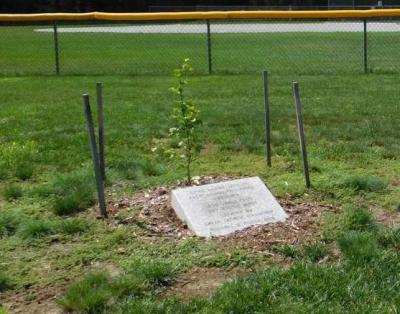Tree-mendous: a hidden history of hardwoods in Rochester
This year might mark only Rochester's third year as a "Tree City," but the town is filled with old, even historic trees. From hybrid elms to beeches, sycamores and towering hemlocks, some of Rochester's trees have a hidden history.
Rochester Historical Commission member Matthew Monteiro, who has organized the town's annual Arbor Days, explained more about the town's leafy lore on December 18, during an informal conversation at Plumb Library.
The Buttonwood Tree
This buttonwood (also known as an American Sycamore) tree, Monteiro explained, was called "The Great Buttonwood." It was mentioned in the 1846 writings of George Emerson, then the president of the Boston Society of Natural History. "In Rochester," he wrote, "[the tree] by the roadside was eleven feet in circumference at four feet from the ground."
More was written about the tree in 1936, Monteiro said, and at that point it measured 14 feet in circumference. At the time, the tree supposedly at least 114 years old.
Monteiro was unsure if the tree, which was located near Leonard's Pond, was still standing. Rochester Conservation Commission member Laurene Gerrior, in attendance at the talk, said that she didn't think it was still around.
Linc Rounseville Memorial Beech
When driving along Rounseville Road, near the intersection with Cushman Road, it's not hard to spot a lone tree in the middle of a hayfield.
The young beech was planted by members of the Rochester Greenways Committee (which has since been largely absorbed by the Conservation Commission) planted the tree in 2007, in honor of Linc Rounseville, the property owner, who had recently passed away.
The tree, said Monteiro, is particular unique because it is intended to be the twin of another beech—Rochester's largest beech tree. The tree is located at the corner of Rounseville Road and Vaughn Hill Road, not far away, where Rounseville grew up.
The "Liberty Tree"
The "Liberty Elm" is a hybrid elm, created to resist the ravages of Dutch elm disease, which killed millions of American elms in the 1930s. In 1985, New Hampshire Boy Scout Ian Burns chose to plant Liberty Elms as his Eagle Scout project; since then, the Boy Scouts of America have partnered with the Elm Research Institute to plant Liberty Elms far and wide.
In 2008, Rochester's Boy Scout Troop 31 pitched in at the dedication of a newly planted "Liberty Elm" on the front lawn of Plumb Memorial Library. A commemorative plaque was unveiled at the ceremony, and Thomas Paine's poem "Liberty Tree" was read.
Gerrior pointed out that there was an original "Liberty Tree," an old elm, planted on the Rochester Common at the time of the American Revolution. "Colonists argued under them, and they celebrated under them," she said. "There was one close by here somewhere."
The "Peace Tree"
Rochester's newest significant tree, a young gingko-biloba, was planted on the Dexters Lane baseball fields in 2017. Former Town Administrator Mike McCue originally donated the sapling to the town in 2015.
The sapling might seem insignificant, but it is actually a sapling from "Hibakujumoku," the "Survivor Tree."
This tree, located 1,370 from the epicenter of the bomb blast that leveled Hiroshama, managed to survive the atomic onslaught. The tree is over 200 years old. Saplings from the survivor tree are distributed around the world as "peace-bearing trees." Rochester is in rare company—one of the other locations to boast such a sapling is the United Nations headquarters in Geneva, Switzerland.















